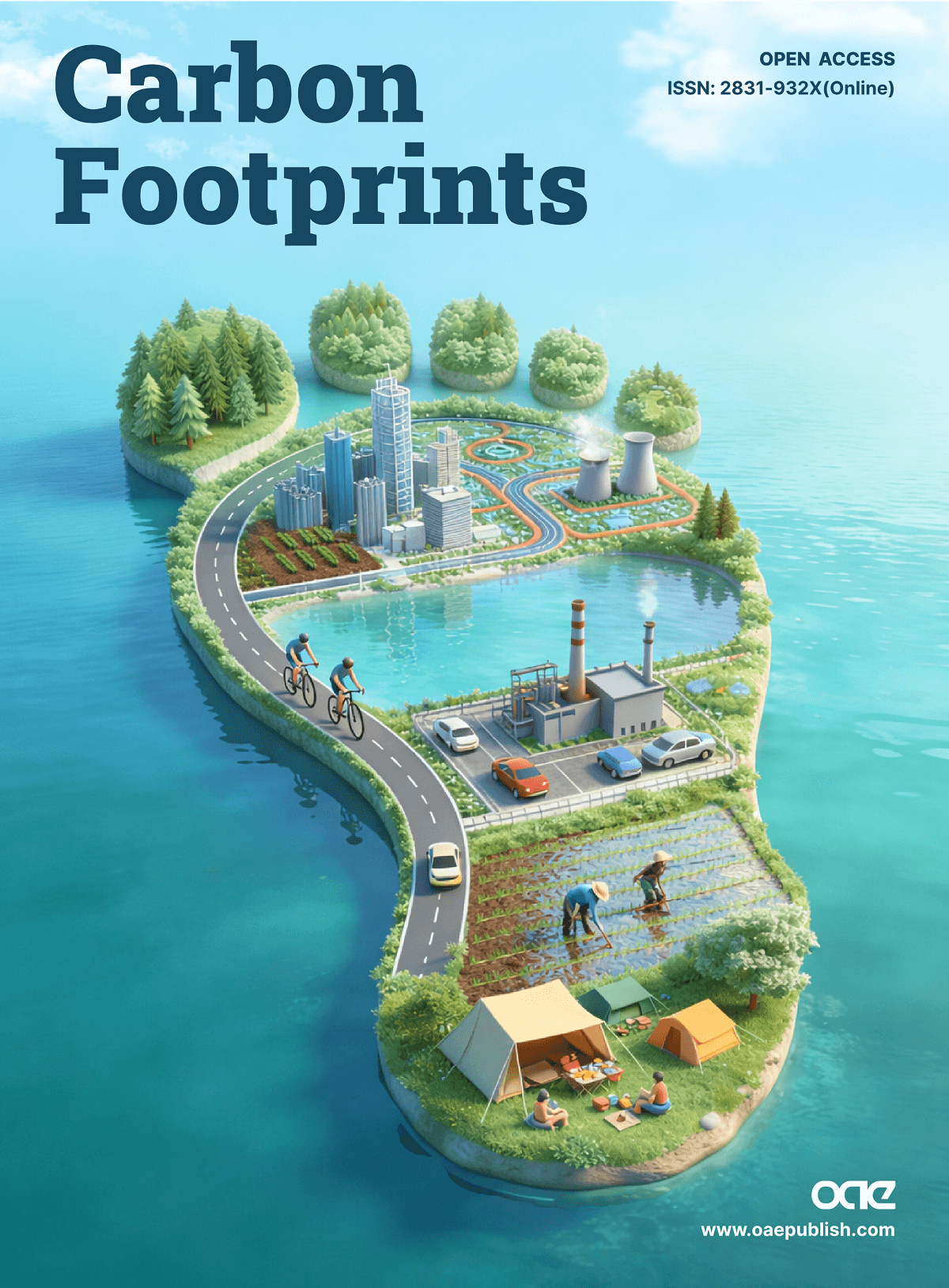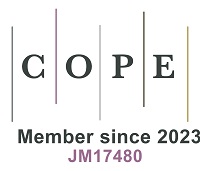REFERENCES
1. Halpern, B. S.; Frazier, M.; Verstaen, J.; et al. The environmental footprint of global food production. Nat. Sustain. 2022, 5, 1027-39.
2. Lenzen, M.; Malik, A.; Li, M.; et al. The environmental footprint of health care: a global assessment. Lancet. Planet. Health. 2020, 4, e271-9.
3. Northey, S.; Haque, N.; Mudd, G. Using sustainability reporting to assess the environmental footprint of copper mining. J. Clean. Prod. 2013, 40, 118-28.
4. Wood, R.; Stadler, K.; Simas, M.; et al. Growth in environmental footprints and environmental impacts embodied in trade: resource efficiency indicators from EXIOBASE3. J. Ind. Ecol. 2018, 22, 553-64.
5. EC-European Commission. 2013/179/EU: Commission Recommendation of 9 April 2013 on the use of common methods to measure and communicate the life cycle environmental performance of products and organisations. Official Journal of the European Union, 2013. https://eur-lex.europa.eu/eli/reco/2013/179/oj/eng (accessed 2025-07-09).
6. Klemeš, J. J.; Fan, Y. V.; Jiang, P. The energy and environmental footprints of COVID-19 fighting measures - PPE, disinfection, supply chains. Energy 2020, 211, 118701.
7. Hiloidhari M, Bandyopadhyay S. Environmental footprints of disposable and reusable personal protective equipment - a product life cycle approach for body coveralls. J. Clean. Prod. 2023, 394, 136166.
8. Turley, M.; Porter, C.; Garrido, T.; et al. Use of electronic health records can improve the health care industry’s environmental footprint. Health. Aff. 2011, 30, 938-46.
9. Viglizzo, E. F.; Frank, F. C.; Carreño, L. V.; et al. Ecological and environmental footprint of 50 years of agricultural expansion in Argentina. Glob. Change. Biol. 2011, 17, 959-73.
10. Louwagie, G.; Northey, G.; Finn, J. A.; et al. Development of indicators for assessment of the environmental impact of livestock farming in Ireland using the Agri-environmental footprint index. Ecol. Indic. 2012, 18, 149-62.
11. Purvis, G.; Louwagie, G.; Northey, G.; et al. Conceptual development of a harmonised method for tracking change and evaluating policy in the agri-environment: the Agri-environmental footprint index. Environ. Sci. Policy. 2009, 12, 321-37.
12. Xian, Y.; Cai, G.; Sang, J.; et al. Agricultural environmental footprint index based on planetary boundary: framework and case on chinese agriculture. J. Clean. Prod. 2023, 385, 135699.
13. Wu, L.; Huang, K.; Yu, Y.; Ridoutt, B. G.; Qu, S.; Xu, M. Addressing regional agro-ecological boundaries: an integrated environmental footprint framework for revealing sustainability gaps in agroecosystems. Environ. Sci. Technol. 2025, 59, 4418-31.
14. Ladha, J. K.; Rao, A. N.; Raman, A. K.; et al. Agronomic improvements can make future cereal systems in South Asia far more productive and result in a lower environmental footprint. Glob. Chang. Biol. 2016, 22, 1054-74.
15. Zhou, Y.; Ji, Y.; Zhang, M.; et al. Exploring a sustainable rice-cropping system to balance grain yield, environmental footprint and economic benefits in the middle and lower reaches of the Yangtze River in China. J. Clean. Prod. 2023, 404, 136988.
16. Sapkota, T. B.; Majumdar, K.; Jat, M. L.; et al. Precision nutrient management in conservation agriculture based wheat production of Northwest India: profitability, nutrient use efficiency and environmental footprint. Field. Crops. Res. 2014, 155, 233-44.
17. Sun, T.; Zhao, C.; Feng, X.; et al. Maize-based intercropping systems achieve higher productivity and profitability with lesser environmental footprint in a water-scarce region of northwest China. Food. Energy. Secur. 2021, 10, e260.
18. Khan, S.; Khan, M. A.; Hanjra, M. A.; et al. Pathways to reduce the environmental footprints of water and energy inputs in food production. Food. Policy. 2009, 34, 141-9.
19. Lathuillière, M. J.; Johnson, M. S.; Galford, G. L.; et al. Environmental footprints show China and Europe’s evolving resource appropriation for soybean production in Mato Grosso, Brazil. Environ. Res. Lett. 2014, 9, 074001.
20. Li, X.; Wang, X.; Engel, B. A.; et al. Integrating environmental footprints and planetary boundaries for assessing environmental sustainability in food production. Sustain. Prod. Consum. 2024, 48, 205-18.
21. Arrieta, E. M.; Aguiar, S.; Fischer, C. G.; et al. Environmental footprints of meat, milk and egg production in Argentina. J. Clean. Prod. 2022, 347, 131325.
22. Dubeux, J. C. B.; Garcia, L.; Queiroz, L. M. D.; et al. Carbon footprint of beef cattle systems in the Southeast United States. Carbon. Footpr. 2023, 2, 2.
23. Kumar, V.; Jat, H. S.; Sharma, P. C.; et al. Can productivity and profitability be enhanced in intensively managed cereal systems while reducing the environmental footprint of production? Assessing sustainable intensification options in the breadbasket of India. Agric. Ecosyst. Environ. 2018, 252, 132-47.
24. Long, W.; Wang, H.; Hou, Y.; et al. Mitigation of Multiple Environmental Footprints for China’s Pig Production Using Different Land Use Strategies. Environ. Sci. Technol. 2021, 55, 4440-51.
25. Ma, Y.; Hou, Y.; Zhang, T.; et al. Decreasing environmental footprints of dairy production systems through optimization of feed rations and origins. J. Clean. Prod. 2024, 461, 142637.
26. Sporchia, F.; Galli, A.; Kastner, T.; Pulselli, F. M.; Caro, D. The environmental footprints of the feeds used by the EU chicken meat industry. Sci. Total. Environ. 2023, 886, 163960.
27. Biesbroek, S.; Bueno-de-Mesquita, H. B.; Peeters, P. H.; et al. Reducing our environmental footprint and improving our health: greenhouse gas emission and land use of usual diet and mortality in EPIC-NL: a prospective cohort study. Environ. Health. 2014, 13, 27.
28. Sáez-Almendros, S.; Obrador, B.; Bach-Faig, A.; Serra-Majem, L. Environmental footprints of Mediterranean versus Western dietary patterns: beyond the health benefits of the Mediterranean diet. Environ. Health. 2013, 12, 118.
29. Naja, F.; Jomaa, L.; Itani, L.; et al. Environmental footprints of food consumption and dietary patterns among Lebanese adults: a cross-sectional study. Nutr. J. 2018, 17, 85.
30. Tepper, S.; Kissinger, M.; Avital, K.; Shahar, D. R. The environmental footprint associated with the Mediterranean Diet, EAT-lancet diet, and the sustainable healthy diet index: a population-based study. Front. Nutr. 2022, 9, 870883.
31. Han, A.; Chai, L.; Liao, X. Demographic scenarios of future environmental footprints of healthy diets in China. Foods 2020, 9.
32. Su, B.; Zhang, C.; Martens, P.; et al. How economic and geographical indicators affect dietary environmental footprint: evidence from China. Ecol. Indic. 2023, 148, 110075.
33. Wang, Y.; Zhang, Z.; Xu, Y.; Li, R.; Chen, W. Motivation, preference, and willingness of Chinese consumers to purchase carbon-labeled eggs. Carbon. Footprints. 2025, 4, 10.
34. Tawiah, V. K.; Zakari, A.; Khan, I. The environmental footprint of China-Africa engagement: an analysis of the effect of China - africa partnership on carbon emissions. Sci. Total. Environ. 2021, 756, 143603.
35. Amore, M. D.; Bennedsen, M.; Larsen, B.; et al. CEO education and corporate environmental footprint. J. Environ. Econ. 2019, 94, 254-73.
36. Cordova, T.; Kissinger, M.; Teschner, N.; et al. Effects of demographic and technological trends on the mitigation of Israel’s environmental footprint. Nat. Sustain. , 2024, 7, 1616-25.
37. Klemeš, J. J.; Fan, Y. V.; Tan, R. R.; Jiang, P. Minimising the present and future plastic waste, energy and environmental footprints related to COVID-19. Renew. Sustain. Energy. Rev. 2020, 127, 109883.
38. Cabernard, L.; Pfister, S.; Oberschelp, C.; et al. Growing environmental footprint of plastics driven by coal combustion. Nat. Sustain. , 2021, 5:139-48.
39. Zhang, Y.; Sun, M.; Hong, J.; et al. Environmental footprint of aluminum production in China. J. Clean. Prod. 2016, 133, 1242-51.
40. Hren, R.; Vujanović, A.; Van Fan, Y.; et al. Hydrogen production, storage and transport for renewable energy and chemicals: an environmental footprint assessment. Renew. Sustain. Energy. Rev. 2023, 173, 113113.
41. Cox, B.; Mutel, C. L.; Bauer, C.; Mendoza Beltran, A.; van Vuuren, D. P. Uncertain Environmental Footprint of Current and Future Battery Electric Vehicles. Environ. Sci. Technol. 2018, 52, 4989-95.
42. Arshi, P. S.; Vahidi, E.; Zhao, F. Behind the scenes of clean energy: the environmental footprint of rare earth products. ACS. Sustain. Chem. Eng. 2018, 6, 3311-20.
43. Fang, K.; Heijungs, R.; De Snoo, G. R. Understanding the complementary linkages between environmental footprints and planetary boundaries in a footprint-boundary environmental sustainability assessment framework. Ecol. Econ. 2015, 114, 218-26.
44. Matustik, J.; Koci, V. What is a footprint? A conceptual analysis of environmental footprint indicators. J. Clean. Prod. 2021, 285, 124833.
45. Rugani, B.; Osset, P.; Blanc, O.; et al. Environmental footprint neutrality using methods and tools for natural capital accounting in life cycle assessment. Land 2023, 12, 1171.
46. Henriksson, P. J.; Cucurachi, S.; Guinee, J. B.; et al. A rapid review of meta-analyses and systematic reviews of environmental footprints of food commodities and diets. Glob. Food. Secur. 2021, 28, 100508.
47. Seppänen, A. V.; Or, Z. A scoping review of interventions to reduce the environmental footprint of healthcare. Value. Health. 2025, 28, 1110-25.
48. Sai, A. R.; Vranken, H. Promoting rigor in blockchain energy and environmental footprint research: a systematic literature review. Blockchain. Res. Appl. 2024, 5, 100169.
49. Madsen, S. T.; Weidema, B. P. Input-output modelling for household activity-level environmental footprints: a systematic literature review. Environ. Res. Lett. 2023, 18, 043003.
50. Chen, R.; Zhang, R.; Han, H. Where has carbon footprint research gone? Ecol. Indic. 2021, 120, 106882.
51. Chen, C. CiteSpace II: detecting and visualizing emerging trends and transient patterns in scientific literature. J. Am. Soc. Inf. Sci. Technol. 2006, 57, 359-77.
52. Pedersen, E.; Remmen, A. Challenges with product environmental footprint: a systematic review. Int. J. Life. Cycle. Assess. , 2022, 27:342-52.
53. Finkbeiner, M. Product environmental footprint-breakthrough or breakdown for policy implementation of life cycle assessment? Int. J. Life. Cycle. Assess. 2014, 19, 266-71.
54. Galatola, M.; Pant, R. Reply to the editorial “Product environmental footprint-breakthrough or breakdown for policy implementation of life cycle assessment? ” written by Prof. Finkbeiner (Int J Life Cycle Assess 19(2):266-271). Int. J. Life. Cycle. Assess. 2014, 19, 1356-60.
55. Pelletier, N.; Allacker, K.; Pant, R.; et al. The European Commission Organisation Environmental Footprint method: comparison with other methods, and rationales for key requirements. Int. J. Life. Cycle. Assess. 2014, 19, 387-404.
56. Manfredi, S.; Allacker, K.; Pelletier, N.; et al. Comparing the European Commission product environmental footprint method with other environmental accounting methods. Int. J. Life. Cycle. Assess. 2015, 20, 389-404.
57. Lehmann, A.; Bach, V.; Finkbeiner, M. Product environmental footprint in policy and market decisions: Applicability and impact assessment. Integr. Environ. Assess. Manag. 2015, 11, 417-24.
58. Lehmann, A.; Bach, V.; Finkbeiner, M. EU product environmental footprint-mid-term review of the pilot phase. Sustainability 2016, 8, 92.
59. Moran, D.; Wood, R. Convergence between the Eora, WIOD, EXIOBASE, and OpenEU’s consumption-based carbon accounts. Econ. Syst. Res. 2014, 26, 245-61.
60. Wood, R.; Stadler, K.; Bulavskaya, T.; et al. Global sustainability accounting-developing EXIOBASE for multi-regional footprint analysis. Sustainability 2014, 7, 138-63.
61. Ivanova, D.; Stadler, K.; Steen-Olsen, K.; et al. Environmental impact assessment of household consumption. J. Ind. Ecol. 2016, 20, 526-36.
62. Ivanova, D.; Vita, G.; Steen-Olsen, K.; et al. Mapping the carbon footprint of EU regions. Environ. Res. Lett. 2017, 12, 054013.
63. Can, M.; Gozgor, G. The impact of economic complexity on carbon emissions: evidence from France. Environ. Sci. Pollut. Res. Int. 2017, 24, 16364-70.
64. Charfeddine, L. The impact of energy consumption and economic development on ecological footprint and CO2 emissions: evidence from a markov switching equilibrium correction model. Energy. Econ. 2017, 65, 355-74.
65. Ulucak, R.; Bilgili, F. A reinvestigation of EKC model by ecological footprint measurement for high, middle and low income countries. J. Clean. Prod. 2018, 188, 144-57.
66. Destek, M. A.; Sarkodie, S. A. Investigation of environmental Kuznets curve for ecological footprint: the role of energy and financial development. Sci. Total. Environ. 2019, 650, 2483-9.
67. Pata, U. K. Renewable and non-renewable energy consumption, economic complexity, CO2 emissions, and ecological footprint in the USA: testing the EKC hypothesis with a structural break. Environ. Sci. Pollut. Res. Int. 2021, 28, 846-61.
68. Ahmed, Z.; Zhang, B.; Cary, M. Linking economic globalization, economic growth, financial development, and ecological footprint: evidence from symmetric and asymmetric ARDL. Ecol. Indic. 2021, 121, 107060.
69. Pata, U. K.; Caglar, A. E. Investigating the EKC hypothesis with renewable energy consumption, human capital, globalization and trade openness for China: evidence from augmented ARDL approach with a structural break. Energy 2021, 216, 119220.
70. Ahmed, Z.; Wang, Z. Investigating the impact of human capital on the ecological footprint in India: an empirical analysis. Environ. Sci. Pollut. Res. Int. 2019, 26, 26782-96.
71. Ahmed, Z.; Wang, Z.; Mahmood, F.; Hafeez, M.; Ali, N. Does globalization increase the ecological footprint? Empirical evidence from Malaysia. Environ. Sci. Pollut. Res. Int. 2019, 26, 18565-82.
72. Nathaniel, S.; Khan, S. A. R. The nexus between urbanization, renewable energy, trade, and ecological footprint in ASEAN countries. J. Clean. Prod. 2020, 272, 122709.
73. Stadler, K.; Wood, R.; Bulavskaya, T.; et al. EXIOBASE 3: developing a time series of detailed environmentally extended multi-regional input-output tables. J. Ind. Ecol. 2018, 22, 502-15.
74. European Commission. Suggestions for updating the organisation environmental footprint (OEF) method. Publications Office of the European Union. https://data.europa.eu/doi/10.2760/424613 (accessed 2025-07-09).
75. European Commission. Supporting information to the characterisation factors of recommended EF Life Cycle Impact Assessment methods: new methods and differences with ILCD. Publications Office of the European Union. https://data.europa.eu/doi/10.2760/671368 (accessed 2025-07-09).
76. EC. PEFCR Guidance document - Guidance for the development of Product Environmental Footprint Category Rules (PEFCRs), version 6.3, December 2017. https://eplca.jrc.ec.europa.eu/permalink/PEFCR_guidance_v6.3-2.pdf (accessed 2025-07-15).
77. Roesch, A.; Sala, S.; Jungbluth, N. Normalization and weighting: the open challenge in LCA. Int. J. Life. Cycle. Assess. 2020, 25, 1859-65.
78. Crenna, E.; Secchi, M.; Benini, L.; et al. Global environmental impacts: data sources and methodological choices for calculating normalization factors for LCA. Int. J. Life. Cycle. Assess. 2019, 24, 1851-77.
79. European Commission. Development of a weighting approach for the environmental footprint. Publications Office of the European Union. https://data.europa.eu/doi/10.2760/446145 (accessed 2025-07-09).
80. Sala, S.; Castellani, V. The consumer footprint: monitoring sustainable development goal 12 with process-based life cycle assessment. J. Clean. Prod. 2019, 240, 118050.
81. Beylot, A.; Secchi, M.; Cerutti, A.; Merciai, S.; Schmidt, J.; Sala, S. Assessing the environmental impacts of EU consumption at macro-scale. J. Clean. Prod. 2019, 216, 382-93.
82. Notarnicola, B.; Sala, S.; Anton, A.; et al. The role of life cycle assessment in supporting sustainable agri-food systems: a review of the challenges. J. Clean. Prod. 2017, 140, 399-409.
83. Springmann, M.; Clark, M. A.; Rayner, M.; Scarborough, P.; Webb, P. The global and regional costs of healthy and sustainable dietary patterns: a modelling study. Lancet. Planet. Health. 2021, 5, e797-807.
84. Sun, Z.; Scherer, L.; Tukker, A.; et al. Dietary change in high-income nations alone can lead to substantial double climate dividend. Nat. Food. 2022, 3, 29-37.
85. Godfray, H. C. J.; Aveyard, P.; Garnett, T.; et al. Meat consumption, health, and the environment. Science 2018, 361, eaam5324.
86. Rotz, C. A.; Asem-Hiablie, S.; Place, S.; et al. Environmental footprints of beef cattle production in the United States. Agric. Syst. 2019, 169, 1-13.
87. Asem-Hiablie, S.; Battagliese, T.; Stackhouse-Lawson, K. R.; et al. A life cycle assessment of the environmental impacts of a beef system in the USA. Int. J. Life. Cycle. Assess. 2019, 24, 441-55.
88. Lynch, J.; Pierrehumbert, R. Climate impacts of cultured meat and beef cattle. Front. Sustain. Food. Syst. 2019, 3, 5.
89. Bryant, C.; Barnett, J. Consumer acceptance of cultured meat: a systematic review. Meat. Sci. 2018, 143, 8-17.
91. Post, M. J.; Levenberg, S.; Kaplan, D. L.; et al. Scientific, sustainability and regulatory challenges of cultured meat. Nat. Food. 2020, 1, 403-15.
92. Fanning, A. L.; O’neill, D. W.; Hickel, J.; et al. The social shortfall and ecological overshoot of nations. Nat. Sustain. 2021, 5, 26-36.
93. Geissdoerfer, M.; Savaget, P.; Bocken, N. M. P.; et al. The circular economy - a new sustainability paradigm? J. Clean. Prod. 2017, 143, 757-68.
94. Kirchherr, J.; Reike, D.; Hekkert, M. Conceptualizing the circular economy: an analysis of 114 definitions. Resour. Conserv. Recycl. 2017, 127, 221-32.
95. Harb, W.; Zaydan, R.; Vieira, M. Improving environmental performance in wine production by life cycle assessment: case of Lebanese wine. Int. J. Life. Cycle. Assess. , 2021, 26, 1146-59.
96. Richardson, K.; Steffen, W.; Lucht, W.; et al. Earth beyond six of nine planetary boundaries. Sci. Adv. 2023, 9, eadh2458.
97. Sala, S.; Crenna, E.; Secchi, M.; et al. Environmental sustainability of European production and consumption assessed against planetary boundaries. J. Environ. Manage. 2020, 269, 110686.
98. Sala, S.; Biganzoli, F.; Mengual, E. S.; et al. Toxicity impacts in the environmental footprint method: calculation principles. Int. J. Life. Cycle. Assess. 2022, 27, 587-602.
99. Igos, E.; Benetto, E.; Meyer, R.; et al. How to treat uncertainties in life cycle assessment studies? Int. J. Life. Cycle. Assess. 2019, 24, 794-807.
100. Barahmand, Z.; Eikeland, M. S. Life cycle assessment under uncertainty: a scoping review. World 2022, 3, 692-717.
101. Bamber, N.; Turner, I.; Arulnathan, V.; et al. Comparing sources and analysis of uncertainty in consequential and attributional life cycle assessment: review of current practice and recommendations. Int. J. Life. Cycle. Assess. 2020, 25, 168-80.
102. Thonemann, N.; Schulte, A.; Maga, D. How to conduct prospective life cycle assessment for emerging technologies? A systematic review and methodological guidance. Sustainability 2020, 12, 1192.
103. Boschiero, M.; De, Laurentiis. V.; Caldeira, C.; et al. Comparison of organic and conventional cropping systems: a systematic review of life cycle assessment studies. Environ. Impact. Assess. Rev. 2023, 102, 107187.
104. Chen, Z.; Xu, C.; Ji, L.; et al. Effects of multi-cropping system on temporal and spatial distribution of carbon and nitrogen footprint of major crops in China. Glob. Ecol. Conserv. 2020, 22, e00895.
105. Dijk, M.; Morley, T.; Rau, M. L.; Saghai, Y. A meta-analysis of projected global food demand and population at risk of hunger for the period 2010-2050. Nat. Food. 2021, 2, 494-501.
106. Belkhir, L.; Elmeligi, A. Assessing ICT global emissions footprint: trends to 2040 & recommendations. J. Clean. Prod. 2018, 177, 448-63.
107. Freitag, C.; Berners-Lee, M.; Widdicks, K.; Knowles, B.; Blair, G. S.; Friday, A. The real climate and transformative impact of ICT: a critique of estimates, trends, and regulations. Patterns 2021, 2, 100340.
108. Malmodin, J.; Lundén, D. The Energy and carbon footprint of the global ICT and E&M Sectors 2010-2015. Sustainability 2018, 10, 3027.
109. Ciez, R. E.; Whitacre, J. F. Examining different recycling processes for lithium-ion batteries. Nat. Sustain. 2019, 2, 148-56.
110. Peters, J. F.; Baumann, M.; Binder, J. R.; et al. On the environmental competitiveness of sodium-ion batteries under a full life cycle perspective - a cell-chemistry specific modelling approach. Sustain. Energy. Fuels. 2021, 5, 6414-29.
111. Intergovernmental Panel On Climate Change (IPCC). Climate change 2022 - impacts, adaptation and vulnerability: working group ii contribution to the sixth assessment report of the intergovernmental panel on climate change. 1 edition. Cambridge University Press, 2023. https://www.cambridge.org/core/product/identifier/9781009325844/type/book (accessed 2020-07-09).
112. Swinburn, B. A.; Kraak, V. I.; Allender, S.; et al. The global syndemic of obesity, undernutrition, and climate change: the lancet commission report. Lancet 2019, 393, 791-846.
113. Whitmee, S.; Haines, A.; Beyrer, C.; et al. Safeguarding human health in the Anthropocene epoch: report of The Rockefeller Foundation-Lancet Commission on planetary health. Lancet 2015, 386, 1973-2028.
114. Romanello, M.; Di Napoli, C.; Drummond, P.; et al. The 2022 report of the Lancet Countdown on health and climate change: health at the mercy of fossil fuels. Lancet 2022, 400, 1619-54.
115. Watts, N.; Amann, M.; Arnell, N.; et al. The 2019 report of The Lancet Countdown on health and climate change: ensuring that the health of a child born today is not defined by a changing climate. Lancet 2019, 394, 1836-78.
116. Tennison, I.; Roschnik, S.; Ashby, B.; et al. Health care’s response to climate change: a carbon footprint assessment of the NHS in England. Lancet. Planet. Health. 2021, 5, e84-92.
117. Malik, A.; Lenzen, M.; McAlister, S.; McGain, F. The carbon footprint of Australian health care. Lancet. Planet. Health. 2018, 2, e27-35.
118. Eckelman, M. J.; Sherman, J. D.; MacNeill, A. J. Life cycle environmental emissions and health damages from the Canadian healthcare system: an economic-environmental-epidemiological analysis. PLoS. Med. 2018, 15, e1002623.
119. Eckelman, M. J.; Huang, K.; Lagasse, R.; Senay, E.; Dubrow, R.; Sherman, J. D. Health care pollution and public health damage in The United States: An Update. Health. Aff. 2020, 39, 2071-9.
120. MacNeill, A. J.; Lillywhite, R.; Brown, C. J. The impact of surgery on global climate: a carbon footprinting study of operating theatres in three health systems. Lancet. Planet. Health. 2017, 1, e381-8.
121. Rizan, C.; Steinbach, I.; Nicholson, R.; Lillywhite, R.; Reed, M.; Bhutta, M. F. The carbon footprint of surgical operations: a systematic review. Ann. Surg. 2020, 272, 986-95.
122. Drew, J.; Christie, S. D.; Tyedmers, P.; Smith-Forrester, J.; Rainham, D. Operating in a climate crisis: a state-of-the-science review of life cycle assessment within surgical and anesthetic care. Environ. Health. Perspect. 2021, 129, 76001.
123. McGain, F.; Muret, J.; Lawson, C.; Sherman, J. D. Environmental sustainability in anaesthesia and critical care. Br. J. Anaesth. 2020, 125, 680-92.
124. Parvatker, A. G.; Tunceroglu, H.; Sherman, J. D.; et al. Cradle-to-gate greenhouse gas emissions for twenty anesthetic active pharmaceutical ingredients based on process scale-up and process design calculations. ACS. Sustain. Chem. Eng. 2019, 7, 6580-91.
125. Belkhir, L.; Elmeligi, A. Carbon footprint of the global pharmaceutical industry and relative impact of its major players. J. Clean. Prod. 2019, 214, 185-94.
126. Kemble, J. P.; Winoker, J. S.; Patel, S. H.; et al. Environmental impact of single-use and reusable flexible cystoscopes. BJU. Int. 2023, 131, 617-22.
127. Sherman, J. D.; Raibley, L. A.; Eckelman, M. J. Life cycle assessment and costing methods for device procurement: comparing reusable and single-use disposable laryngoscopes. Anesth. Analg. 2018, 127, 434-43.
128. Dong, D.; Van Oers, L.; Tukker, A.; et al. Assessing the future environmental impacts of copper production in China: Implications of the energy transition. J. Clean. Prod. 2020, 274, 122825.
129. Wang, Q. C.; Lu, T.; Chen, H. S.; et al. Tracing environmental footprint of copper wire rod manufacturing in China. Resour. Conserv. Recycl. 2024, 204, 107503.
130. Norgate, T.; Haque, N. Using life cycle assessment to evaluate some environmental impacts of gold production. J. Clean. Prod. 2012, 29-30, 53-63.
131. He, Y.; Hosseinzadeh-Bandbafha, H.; Kiehbadroudinezhad, M.; et al. Environmental footprint analysis of gold recycling from electronic waste: a comparative life cycle analysis. J. Clean. Prod. , 2023, 432, 139675.
132. Chowdhury, N. A.; Deng, S.; Jin, H.; et al. Sustainable recycling of rare-earth elements from NdFeB magnet swarf: techno-economic and environmental perspectives. ACS. Sustain. Chem. Eng. 2021, 9, 15915-24.
133. Altay, M. B.; Kalipçioğlu, C.; Kurt, Z. Comparative life cycle assessment of uranium recovery from brine. Resour. Conserv. Recycl. 2022, 181, 106237.
134. Zhou, H.; Basarir, H.; Poulet, T.; et al. Life cycle assessment of recycling copper slags as cement replacement material in mine backfill. Resour. Conserv. Recycl. 2024, 205, 107591.
135. Kuipers, K. J. J.; Van Oers, L. F. C. M.; Verboon, M.; et al. Assessing environmental implications associated with global copper demand and supply scenarios from 2010 to 2050. Glob. Environ. Change. 2018, 49, 106-15.
136. Lagos, G.; Peters, D.; Videla, A.; et al. The effect of mine aging on the evolution of environmental footprint indicators in the Chilean copper mining industry 2001-2015. J. Clean. Prod. 2018, 174, 389-400.
137. Da Tan, T. Y.; Duane, B.; Hussein, A.; et al. Environmental sustainability of post-orthodontic dental retainers: a comparative life-cycle assessment of Hawley and Essix retainers. Eur. J. Orthod. 2024, 46.
138. Petre, M. A.; Malherbe, S. Environmentally sustainable perioperative medicine: simple strategies for anesthetic practice. Can. J. Anaesth. 2020, 67, 1044-63.
139. Hunfeld, N.; Diehl, J. C.; Timmermann, M.; et al. Circular material flow in the intensive care unit-environmental effects and identification of hotspots. Intensive. Care. Med. 2023, 49, 65-74.
140. Prasad, P. A.; Joshi, D.; Lighter, J.; et al. Environmental footprint of regular and intensive inpatient care in a large US hospital. Int. J. Life. Cycle. Assess. 2022, 27, 38-49.
141. Lichtnegger, S.; Meissner, M.; Paolini, F.; Veloz, A.; Saunders, R. Comparative life cycle assessment between single-use and reprocessed IPC sleeves. Risk. Manag. Healthc. Policy. 2023, 16, 2715-26.
142. Neppach, S.; Nunes, K. R. A.; Schebek, L. Organizational environmental footprint in german construction companies. J. Clean. Prod. 2017, 142, 78-86.
143. Al-Hamrani, A.; Kim, D.; Kucukvar, M.; et al. Circular economy application for a Green Stadium construction towards sustainable FIFA world cup Qatar 2022TM. Environ. Impact. Assess. Rev. 2021, 87, 106543.
144. Sinha, R.; Lennartsson, M.; Frostell, B. Environmental footprint assessment of building structures: a comparative study. Build. Environ. 2016, 104, 162-71.
145. Baykara, H.; Riofrio, A.; Garcia-Troncoso, N.; et al. Chitosan-cement composite mortars: exploring interactions, structural evolution, environmental footprint and mechanical performance. ACS. Omega. 2024, 9, 24978-86.
146. Vijerathne, D.; Wahala, S.; Illankoon, C. Impact of crushed natural aggregate on environmental footprint of the construction industry: enhancing sustainability in aggregate production. Buildings 2024, 14, 2770.
147. Albrecht, S. V.; Hellerbrand, S.; Weininger, F.; Thiel, C. Strategies for minimizing environmental impact in construction: a case study of a cementitious 3D printed lost formwork for a staircase. Materials 2025, 18, 825.
148. Ajayi, S. O.; Oyedele, L. O.; Ilori, O. M. changing significance of embodied energy: a comparative study of material specifications and building energy sources. J. Build. Eng. 2019, 23, 324-33.
149. Turk, J.; Pranjić, A. M.; Tomasin, P.; et al. Environmental performance of three innovative calcium carbonate-based consolidants used in the field of built cultural heritage. Int. J. Life. Cycle. Assess. 2017, 22, 1329-38.
150. Monteleone, B.; Baldereschi, E.; Fabbri, N.; et al. A sustainability assessment of the foundry production process in Italy. Sustain. Prod. Consum. 2024, 46, 491-501.
151. Kjaer, L.; Høst-Madsen, N.; Schmidt, J.; et al. Application of environmental input-output analysis for corporate and product environmental footprints-learnings from three cases. Sustainability 2015, 7, 11438-61.
152. Cimprich, A.; Young, S. B. Environmental footprinting of hospitals: organizational life cycle assessment of a Canadian hospital. J. Ind. Ecol. 2023, 27, 1335-53.
153. Kaas, J.; Verbeek, M.; Li, W. W. L.; et al. Climate impact of early-stage NSCLC treatment: A comparison between radiotherapy and surgery using life cycle assessment. Radiother. Oncol. 2025, 202, 110601.
154. Unger, S.; Landis, A. Assessing the environmental, human health, and economic impacts of reprocessed medical devices in a Phoenix hospital’s supply chain. J. Clean. Prod. 2016, 112, 1995-2003.
155. Boberg, L.; Singh, J.; Montgomery, A.; Bentzer, P. Environmental impact of single-use, reusable, and mixed trocar systems used for laparoscopic cholecystectomies. PLoS. One. 2022, 17, e0271601.
156. Maloney, B.; McKerlie, T.; Nasir, M.; et al. The environmental footprint of single-use versus reusable cloths for clinical surface decontamination: a life cycle approach. J. Hosp. Infect. 2022, 130, 7-19.
157. López-Muñoz, P.; Martín-Cabezuelo, R.; Lorenzo-Zúñiga, V.; et al. Environmental footprint and material composition comparison of single-use and reusable duodenoscopes. Endoscopy 2025, 57, 116-23.
158. Chang, J. H.; Woo, K. P.; Silva de Souza Lima Cano, N.; et al. Does reusable mean green? Comparison of the environmental impact of reusable operating room bed covers and lift sheets versus single-use. Surgeon 2024, 22, 236-41.
159. Bertolo, R.; Gilioli, V.; Veccia, A.; et al. Institutional micro-cost comparative analysis of reusable vs single-use cystoscopes with assessment of environmental footprint. Urology 2024, 188, 70-6.
160. Danish, A.; Torres, A. S.; Moro, C.; et al. Hope or hype? Evaluating the environmental footprint of reclaimed fly ash in geopolymer production. Resour. Conserv. Recycl. 2024, 205, 107564.
161. Yu, Z.; Nurdiawati, A.; Kanwal, Q.; et al. Assessing and mitigating environmental impacts of construction materials: insights from environmental product declarations. J. Build. Eng. 2024, 98, 110929.








